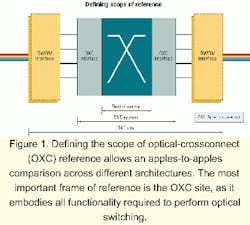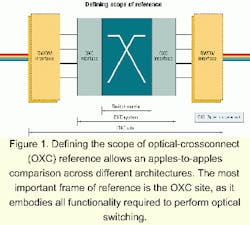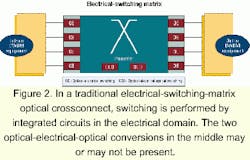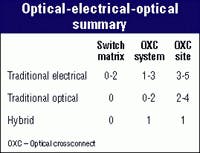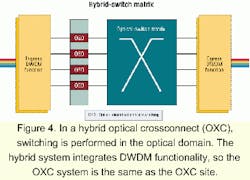Moving toward an integrated optical-core network
Hybrid optical crossconnects allow carriers to make use of embedded systems and technologies while providing an upgrade path to the future.
STEPHEN ROSE, Cinta Networks
Increasing bandwidth demands on the backbone of the telecommunications network and innovations in optical technology have led to an emerging trend of managing services at the photonic layer. To meet customer needs for newer services while retaining the advantages that traditional technologies provide, the hybrid optical crossconnect is emerging as one of the cornerstone network elements that will enable the future while maintaining compatibility with the past.
Developed in the early 1980s to alleviate barriers created by a sudden onslaught of proprietary technologies, SONET was soon accepted as the standard for wide-area optical networking. Ideal for circuit-switched voice and leased-line service offerings, SONET found itself overwhelmed in the early 1990s by growing data traffic pressures and the need to deliver bandwidth on demand. SONET's inefficient handling of this data traffic was the first sign of its slide from popularity in backbone transport networks.
Toward the mid-1990s, WDM technology was introduced and hailed as the "magic bullet" for the explosion of data traffic that started to burden backbone networks. WDM allows multiple wavelengths of light to travel down the same fiber independently, each one carrying its own signal. Additionally, since the different wavelengths of light travel down the fiber largely independent of one another, it is possible for these multiple wavelengths to carry signals of different bit rates and formats, such as Internet protocol, ATM, SONET/SDH, and Ethernet.
As with many new technologies, however, WDM was initially viewed only with respect to how it could augment older, proven technology. To this end, WDM was primarily used to carry multiple SONET signals within the same fiber-WDM equipment was used as a point-to-point virtual fiber multiplier, which created "stacked" SONET rings.
WDM is now viewed not with respect to the past, but with an eye toward the future, which is evident when noticing that over the past few years, vendors and carriers have begun to explore newer network architectures that would be impractical without WDM. Additionally, as further innovations in optical technology appear, we begin to see synergistic relationships between these newer technologies that allow us to fundamentally change the way the backbone network operates.These technologies include software algorithms pushing toward a meshed network, tunable passive optical components that enable greater flexibility to manage wavelengths, newer fibers for increased transmission capacity, and many others. However, the goal of increasing network capacity, while at the same time lowering transport cost, must not be overlooked. One of the most promising recent developments in optical technology, the widely tunable laser, is offering both an architectural paradigm shift and a cost reduction in WDM transport.
Conventional uses for tunable lasers involve applications such as sparing. Currently, a carrier needs to have spare fixed-wavelength lasers available for every wavelength used in the network. Tunable lasers can be used as spares, taking the place of many fixed-wavelength spares. However, to truly take advantage of this innovation, we must look forward at how tunable lasers might enable better, more dynamic, economic networks. The place where tunable lasers have the biggest impact is in the core of the optical network by enabling dynamic wavelength translation.
Data traffic today far outpaces voice traffic in both actual volume and growth rate. Given the limitations that SONET-based architectures impose on unpredictable data traffic, it is becoming clear that technologies must be adopted that scale efficiently, allow for dynamic provisioning, and provide SONET-equivalent (if not better) protection/restoration and performance-monitoring capabilities.
Both traditional carriers and emerging service providers are addressing these issues by building high-speed optical-core networks that are fed by a system of regional, metropolitan, and access networks. These optical-core networks are still based generally on SONET ring topologies with add/drop multiplexers (ADMs) in conjunction with point-to-point DWDM transport technology. However, since this approach is based on SONET's antiquated voice-based architecture, the result is still a largely static and operationally expensive ring-based network.Optical crossconnects (OXCs) are rapidly emerging as the solution that meets these requirements. They enable carriers to flexibly manage and rapidly allocate bandwidth and provide rapid restoration in case of failures. They also enable service providers to easily migrate from traditional SONET rings to a mesh-based architecture, eliminating entire equipment layers and numerous costly components. These optical-switching solutions will deliver the ultimate goal of network services: real-time optical-service provisioning with lower operational overhead-still guaranteeing SONET-like quality of service.
Unfortunately, while OXCs hold tremendous promise, first-generation technology does not deliver the scalability, efficiency, or the manageability necessary to meet long-term carrier requirements. As the foundation for a truly effective optical-core network, a "next-generation" OXC is necessary-one that possesses the following characteristics:
- Future-proof scalability. Carriers must be able to meet the needs of today's bandwidth demands, as well as those of tomorrow, with the same system. Therefore, graceful scalability to 1,000 ports and more is essential.
- Advanced performance monitoring. Real-time traffic monitoring and the ability to isolate faults are critical.
- Improved network reliability. There should be multiple protection options at the optical layer, providing SONET-grade reliability and protection switching without the need for external SONET ADMs.
- Wavelength conversion. Signals should be able to change wavelengths within the core to allow greater flexibility and prevent blocking situations.
- Bit-rate and protocol-independent switching fabric. The actual components that perform the switching of signals should not be dependent upon the data rate or the format of the signal being switched.
- Simplified network management. Service providers should be able to rapidly design and accurately test and implement various network configurations. Therefore, next-generation OXCs should allow real-time, end-to-end bandwidth monitoring and provisioning.
- Economic design. Designs that minimize cost, footprint, and power consumption are essential.
There is significant excitement about "all-optical" crossconnects. One must be careful however, as these statements often refer only to the switching matrix and not to the OXC system as a whole-nor to the OXC site as a whole (the OXC system as well as the DWDM equipment necessary to access the wavelength-granularity signals.)
Figure 1 illustrates these different scopes of reference. "All-optical" devices are reportedly good because they eliminate optical-electrical-optical (OEO) conversions. OEO conversions are quite costly in money, power, and space. However, OEO conversions "clean up" messy optical signals and enable extensive performance-monitoring capabilities, neither of which are available in the optical domain. Therefore, OEOs are a tradeoff-it is clear that they should be eliminated to the greatest extent possible, but eradicating them completely would sacrifice network functionality. There are already a number of vendors exploring different ways to perfect the next-generation OXC. Currently, there are three main approaches (see Table): traditional electrical-matrix OXCs, traditional optical-matrix OXCs, and hybrid OXCs.
Most of today's OXC sites contain electrical-switch matrices. In this style of crossconnect (see Figure 2), light pulses are first demultiplexed by DWDM equipment to access the wavelength-granularity signals. They are then passed to the OXC where they are converted into electrical signals. These electrical signals are switched in the electrical domain by bit-rate and protocol-dependent application-specific integrated circuits. Once through the switching matrix, the signals are converted back into optical signals and passed to the DWDM equipment for remultiplexing. Traditionally, each DWDM terminal has an OEO, and the OXC can have from one to three OEOs-a total of up to five OEOs at an OXC site.
The advantages of electrical switching are twofold. First, having an electrical signal allows crossconnect operations on subrate (subwavelength) signals. Since most of the core-network signal formats are based on time-division multiplexing (TDM), such as SONET, they consist of many lower-rate signals multiplexed together in time. These smaller signals can be easily extracted and switched on to other large outgoing signals in the electrical domain, a feature impossible in the optical domain. Second, this design allows for significant performance-monitoring capabilities that can be performed only in the electrical domain, such as SONET overhead processing.Unfortunately, the drawback to the electrical-core architecture is severe, and it relates to scalability. The ability of the electrical core to operate on subrate signals implies a switching granularity that is below the line rate. In this case, the matrix has the granularity of the lowest switchable subrate signal.
When referring to the port count of an electrical switch, the base port count is the number of signals that can be switched at the switching granularity. Larger signals can be switched by demultiplexing a line-rate signal into many switch-granularity signals, making sure all subrate signals switch alongside one another and are recombined after leaving the matrix to form the original line-rate signal. Thus, multiple switch-granularity ports are consumed to switch entire individual line-rate signals. When that happens, the port count goes down by the ratio of the line rate to the switch granularity. As the bit rates in the core of the optical network continue to increase, the usefulness of electrical switches decreases, because they can switch fewer signals at the faster line rates.
Optical matrices (see Figure 3) operate on signals while they remain in the optical domain and can be thought of as mirrors that direct light from one input to one output. In fact, many optical matrices consist of thousands of tiny mirrors that do exactly that. At an optical OXC site, light pulses are first demultiplexed by DWDM equipment to access the wavelength-granularity signals. They are then passed to the OXC, where they are switched by a bit-rate and protocol-independent optical-switch matrix that does not suffer from the same scalability limitations as the electrical OXC. From there, the signals are handed back to the DWDM equipment for remultiplexing.
The optical matrix has no OEOs and can only monitor optical-signal levels. To interface to DWDM equipment, OEO port cards are typically installed at the ingress and egress to the switch matrix. Including these and the OEOs for the DWDM equipment, there can be up to four OEOs at an optical OXC site. Adding these OEOs increases cost, power consumption, and space usage, but allows the optical OXC to monitor the signal in the electrical domain. The optical-switch matrix remains bit-rate and protocol independent, but the optical OXC no longer is.One work-around to the problem of multiple OEOs surrounding an optical matrix is to provide optically transparent access to the switching matrix-the so-called optical-optical-optical (OOO) interface. Given advanced optical breakthroughs, this solution would be optimal. For now, however, this adds significant network-management complexity because optical signals have a limited transmission distance before an OEO must take place-and OOO capability enables optical path lengths to change without regard to these limits.
The hybrid OXC (see Figure 4), as its name suggests, combines electrical and optical technologies to achieve an OEO minimization while increasing network manageability. This OXC features an all-optical matrix and a single OEO conversion within an entire OXC site as it integrates DWDM capabilities. As mentioned above, OEOs are costly across many dimensions, but they are also useful.
The objective of any network designer is to minimize network cost (equipment cost and operational cost) while maintaining or increasing the desired network functionality. The goal isn't necessarily to eliminate all OEO conversions, but rather to reduce them to the minimum number to reduce cost without compromising functionality. The hybrid OXC achieves that by making use of tunable lasers and other tunable elements to redefine DWDM and OXC architectures instead of simply providing incremental feature improvements.
That wavelength translation can now migrate to the core in a dynamic fashion to allow further integration of network functionality. One notable application is the migration of protection and restoration schemes to the optical layer. Hybrid OXCs based on tunable lasers provide the migration path from SONET ADM-based protection to OXC-based protection in a graceful manner. The net result of this architecture combines the best of both worlds. The hybrid OXC dramatically reduces equipment and operational costs, is highly scalable, and uses less power. However, thanks to the single OEO conversion, it still features advanced performance monitoring and improved signal integrity.
One drawback of traditional optical-matrix OXCs is that the entire matrix must be deployed in order to switch any optical signals. With the hybrid approach, only signals to be switched pass through the matrix. The matrix itself grows with the number of switched signals that minimize up-front costs. That is useful as carriers make the transition to wavelength-based services while retaining traditional services in the TDM domain on the same fiber.
The future of the backbone telecommunications network is optical. When that future will be truly "all optical" from end to end is still an unknown. For now, the goal is to make use of the advantages that optical breakthroughs provide, while keeping only the best of existing proven technologies and the functionality that they bring. To this end, the best solution for carriers today and for the near future is equipment that enables utilization of embedded technologies while also providing a migration path to the inevitable future.
Stephen Rose is a product marketing manager at Cinta Networks (San Jose, CA). He can be reached via the company's Website, www.cintanetworks.com.
